- 7 Top Flite Golf Clubs XL for Improved Performance - September 28, 2024
- Top Flite Golf Clubs: Top 5 Reasons to Choose Them - September 28, 2024
- Top 3 Golf Club Fitters for a Perfect Swing - September 28, 2024
When choosing the best shaft material for your golf clubs, consider your swing speed and style. Steel shafts provide less torque and twisting, making them ideal for golfers with faster swing speeds who prioritize control and accuracy. Graphite shafts, on the other hand, offer vibration-dampening properties and lighter weights, suiting golfers with slower swing speeds who prioritize distance and forgiveness. Understanding the properties of each material, including carbon fiber, steel, and hybrid options, will help you select the right shaft for your game. By exploring the details of shaft flex, torque, and weight, you'll be able to tap into the full potential of your clubs.
Key Takeaways
- Steel shafts provide less torque and twisting, making them ideal for golfers with faster swing speeds who prioritize control and accuracy.
- Graphite shafts are lighter, promoting faster speeds and offering vibration-dampening properties for a softer feel at impact, making them suitable for golfers with slower swing speeds.
- Carbon fiber shafts deliver exceptional strength and minimal weight, making them an attractive option for golfers seeking to optimize their game.
- Hybrid shafts offer a unique blend of stability, feel, and distance by combining the benefits of steel and graphite shafts.
- The right shaft material can greatly impact the overall performance of the club head, affecting distance, accuracy, and control.
Understanding Shaft Materials
When selecting a golf club, understanding the characteristics of different shaft materials is essential, as each material responds uniquely to your swing dynamics.
You need to weigh how steel and graphite shafts will interact with your swing mechanics to achieve peak performance.
Steel shafts, being the heaviest, provide less torque and twisting, making them ideal for golfers with faster swing speeds who prioritize control and accuracy.
On the other hand, graphite shafts are lighter, promoting faster speeds and offering vibration-dampening properties for a softer feel at impact, making them suitable for golfers with slower swing speeds who prioritize distance and forgiveness.
The right shaft material can greatly impact the overall performance of your club head, affecting distance, accuracy, and control.
By understanding the characteristics of each material, you can make an informed decision that aligns with your individual swing style and preferences.
This knowledge will help you refine your golf shaft flex, resulting in improved performance and a more enjoyable game.
Properties of Carbon Fiber
When you're considering carbon fiber shafts, you're looking for exceptional strength and minimal weight.
Carbon fiber delivers on both fronts, boasting high tensile strength that can withstand the forces generated by your swing while keeping your club ultra-lightweight.
This remarkable combination of properties makes carbon fiber an attractive option for golfers seeking to optimize their game.
High Tensile Strength
You'll appreciate the significance of high tensile strength in carbon fiber, a property that enables it to withstand immense stress without deforming or breaking.
This exceptional strength is due to the strong bonds between carbon atoms, providing exceptional strength-to-weight ratios.
In fact, some high-modulus carbon fibers exhibit tensile strengths up to 10 GPa (1450 ksi), making them ideal for golf club shafts.
When it comes to graphite shafts, high tensile strength is vital for maintaining stability and accuracy.
Shaft manufacturers leverage this property to generate faster ball speeds and longer distances.
The combination of high tensile strength and stiffness, ranging from 300 to 700 GPa (43.5 to 101.5 ksi), makes carbon fiber an unbeatable material for high-performance shafts.
As you generate clubhead speed, the shaft's high tensile strength guarantees it can handle the stress, resulting in a more consistent and powerful swing.
With high-tensile-strength carbon fibers, you can trust your shaft to perform at its best, giving you a competitive edge on the course.
Ultra-Lightweight Design
With its incredible tensile strength-to-weight ratio, carbon fiber enables the creation of ultra-lightweight shafts that deliver improved feel, stability, and accuracy without sacrificing performance. As a golfer, you'll appreciate the benefits of carbon fiber's exceptional strength-to-weight ratio, which allows for shafts that are notably lighter without compromising on performance.
Here's a comparison of carbon fiber's properties with other materials:
| Material | Tensile Strength | Weight | Tensile Modulus |
|---|---|---|---|
| Carbon Fiber | up to 10 times greater than steel | 2-3 times lighter than steel | up to 70-80 GPa |
| Steel | – | – | 200-210 GPa |
| Graphite | – | – | 30-40 GPa |
| Titanium | – | – | 160-170 GPa |
| Aluminum | – | – | 70-80 GPa |
The ultra-lightweight design of carbon fiber shafts allows for a substantial reduction in weight, with some shafts weighing as little as 29g. This reduction in weight enables you to generate more speed and distance without sacrificing feel and stability. Additionally, the use of low resin content pre-preg in ultra-lightweight shaft design allows for a smoother feel during the swing, while maintaining the necessary stiffness and strength. With carbon fiber shafts, you can experience the benefits of a lighter weight without compromising on performance, making it an ideal choice for graphite golf enthusiasts.
Steel Shaft Characteristics
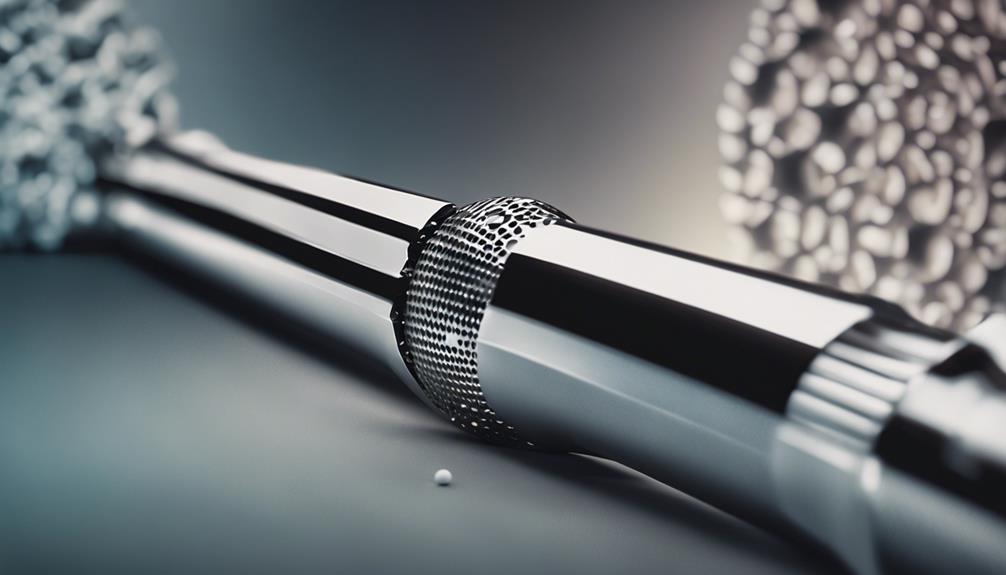
As you consider steel shafts for your golf clubs, you'll want to examine their weight and flexibility, as well as their durability and strength.
You'll find that steel shafts offer a unique combination of these characteristics, which can noticeably impact your game.
Weight and Flexibility
Steel shafts are generally heavier than graphite shafts. However, modern steel shafts are designed to be lighter, making them more suitable for golfers who prefer a faster swing tempo. The weight of a steel shaft affects the overall feel and balance of your club, which in turn influences your swing dynamics.
With steel shafts, you have more flex options to choose from, allowing you to fine-tune your club to your specific swing characteristics.
The flexibility of a steel shaft determines how much it bends during your swing, which affects the trajectory and distance of your shots. A more flexible shaft will produce a higher trajectory, while a stiffer shaft will result in a lower, more penetrating shot.
Durability and Strength
Steel shafts' exceptional durability and strength make them a reliable choice for golfers seeking a consistent, high-performance swing.
You'll appreciate the added stability and rigidity they provide, allowing for a more controlled feel throughout your swing.
This is especially important for golfers who prioritize control over distance, particularly those with faster swing speeds.
Steel shafts' durability is unmatched, making them less prone to damage than graphite shafts.
They're also resistant to wear and tear, ensuring a consistent performance even after repeated use.
Additionally, stainless steel shafts provide strength without sacrificing feel, giving you the confidence to take on any shot.
With steel golf shafts, you can trust that your clubs will withstand the demands of your game, round after round.
Their durability and strength make them an excellent option for golfers who demand precision and consistency from their equipment.
Graphite Shaft Benefits
When choosing a graphite shaft, you can expect a softer feel at impact and reduced fatigue during play, thanks to its vibration-dampening properties.
This is especially beneficial for golfers with slower swing speeds, as graphite shafts provide customization options with various flex choices to suit individual swing characteristics.
As a result, you can prioritize distance and forgiveness while enjoying a more comfortable playing experience.
In the golf shaft industry, graphite shafts have gained popularity due to their unique benefits.
Being lighter than steel shafts, they promote faster swing speeds and increased distance, making them a popular choice for drivers and fairway woods.
Additionally, graphite shafts have better vibration-dampening properties compared to steel shafts, providing a smoother feel during the swing and reducing the risk of fatigue.
By incorporating a graphite shaft into your club, you can improve your overall game, even with slower swing speeds.
With the right flex and customization, you can achieve better feel and feedback, allowing you to sense impact and make adjustments to your swing.
Hybrid Shaft Options
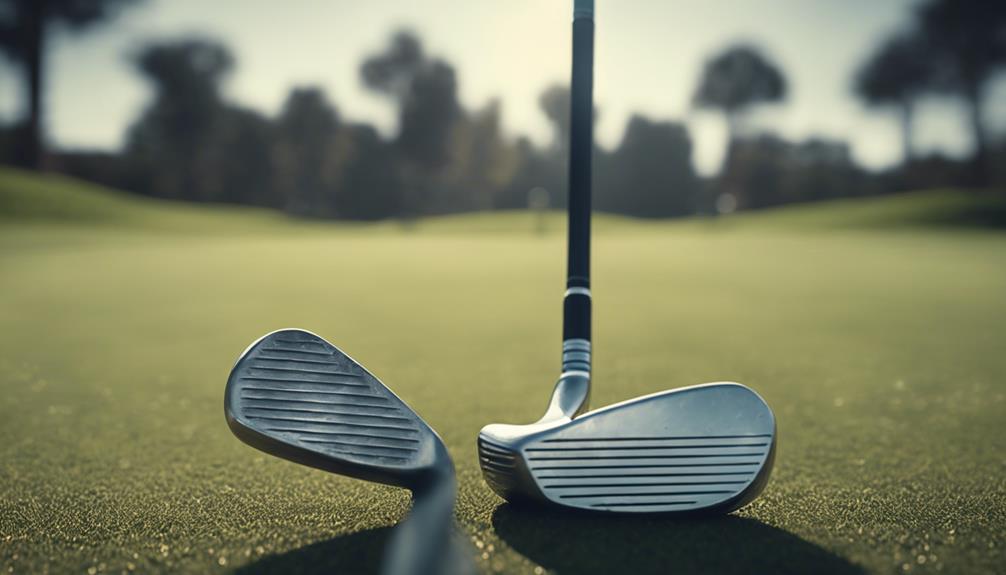
As you explore the world of golf shafts, you'll discover that hybrid shafts have emerged as a compelling option, offering a unique blend of stability, feel, and distance.
By combining the benefits of steel and graphite shafts, hybrid shafts provide a balance that's hard to find with traditional materials.
For instance, Aerotec's Steelfiber iron shaft and Grafalloy Bi-Matrix are successful hybrid shafts that bring together the strength of steel and the flexibility of graphite.
These shafts are designed to provide a smooth, consistent feel throughout the swing, while maintaining the accuracy and control of steel shafts.
The goal of hybrid shafts is to create a shaft that offers the stability of steel in the lower sections and the flexibility of graphite in the upper sections, resulting in increased distance and accuracy.
If you're a golfer who wants to take advantage of the benefits of both steel and graphite shafts, but can't decide between the two, hybrid shafts are definitely worth considering.
They offer a unique solution that can help you improve your game.
Shaft Flex and Torque
Shaft flex refers to the amount of bend or flexibility in the shaft during your swing. Stiff flex shafts are ideal for golfers with high swing speeds, as they provide more stability and control. On the other hand, flexible shafts are better suited for those with slower swing speeds, allowing for more forgiveness and distance.
Torque, measured in degrees, is the twisting force that occurs during your swing. A higher torque rating indicates more flexibility, while a lower rating denotes less flexibility.
When selecting the right shaft, it's vital to examine your swing speed, tempo, and style. If you have a fast swing speed, you'll want a shaft with lower torque to minimize twisting and maximize a more consistent ball flight. Conversely, golfers with slower swing speeds may benefit from a shaft with higher torque to generate more power and distance.
Material Selection Criteria
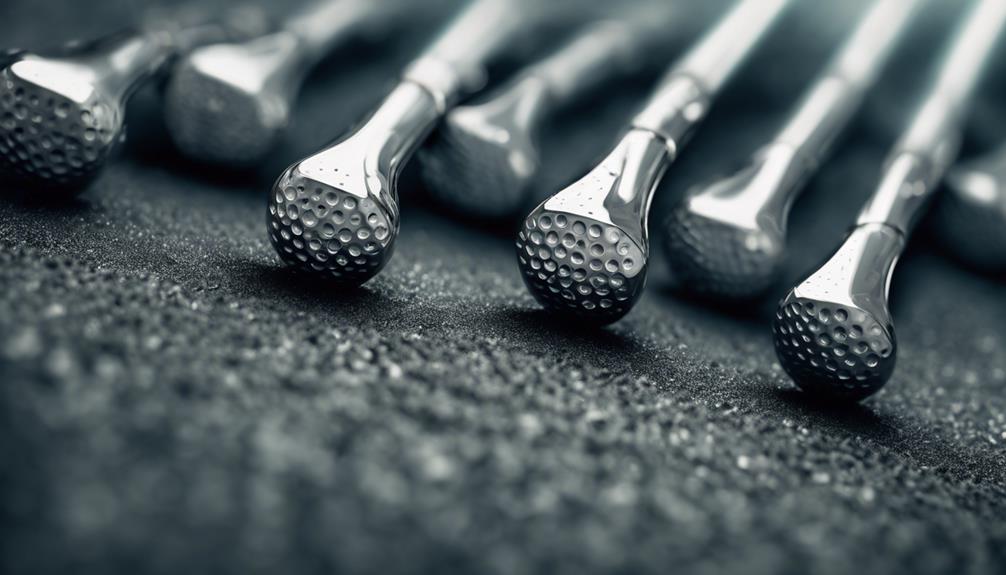
When selecting a shaft material, you'll need to weigh the weight and density factors that affect the club's overall performance.
You'll want to think about how the material will perform under various conditions, such as temperature and humidity, to guarantee it meets your needs.
Weight and Density Factors
In selecting the ideal shaft material, golfers must consider weight and density factors, which prominently impact swing speed, tempo, and overall performance.
You'll find that steel shafts are generally heavier than graphite shafts, with weights ranging from 95-120 grams for irons and 55-65 grams for drivers. Graphite shafts, on the other hand, are much lighter, with weights ranging from 45-75 grams for irons and 35-55 grams for drivers.
The density of a shaft material also affects its weight, with steel having a higher density than graphite, which means a steel shaft of the same volume will be heavier than a graphite shaft.
When choosing a shaft material, you should consider how the weight and density will affect your swing.
A lighter shaft can increase your swing speeds, but may sacrifice some control. Conversely, a heavier shaft can provide more stability, but may slow down your swing tempo.
The ideal shaft weight and density for you'll depend on your individual swing characteristics, including your speed, tempo, and style.
Performance Under Various Conditions
As you weigh the ideal shaft material for your golf clubs, its performance under various conditions becomes a key factor in your selection, particularly since different materials respond differently to changes in temperature, humidity, and other environmental factors.
When it comes to playing in cold and wet conditions, graphite shafts are the better choice. Their vibration-dampening properties help reduce shock and improve feel, allowing you to maintain control and consistency.
On the other hand, steel shafts are more durable and less prone to damage in harsh weather conditions, making them a better option for golfers who frequently play in extreme temperatures or weather.
It's essential to weigh how the shaft material will perform in different conditions, as it can drastically impact your game. Graphite shafts produce higher trajectories and more spin, while steel shafts produce lower trajectories and less spin.
Weight and Swing Speed
Shaft weight substantially influences your golf game, particularly when it comes to matching your swing speed with the right material.
As a golfer, you need to think about your swing speed when selecting a shaft, as this factor greatly impacts your performance.
Steel shafts, weighing between 95-130 grams, are more suitable for golfers with faster swing speeds, providing a consistent and controlled feel.
On the other hand, graphite shafts, weighing between 50-70 grams, are better suited for golfers with slower swing speeds, offering more distance and forgiveness.
If you're a golfer with a swing speed below 75 mph, you may benefit from ultra-light graphite shafts weighing around 40-50 grams, which can increase distance and ball speed.
Finding the ideal shaft weight that matches your swing speed is crucial, as this can greatly affect your overall performance.
By choosing the right shaft material and weight, you can optimize your game and take your skills to the next level.
Feel and Feedback Factors
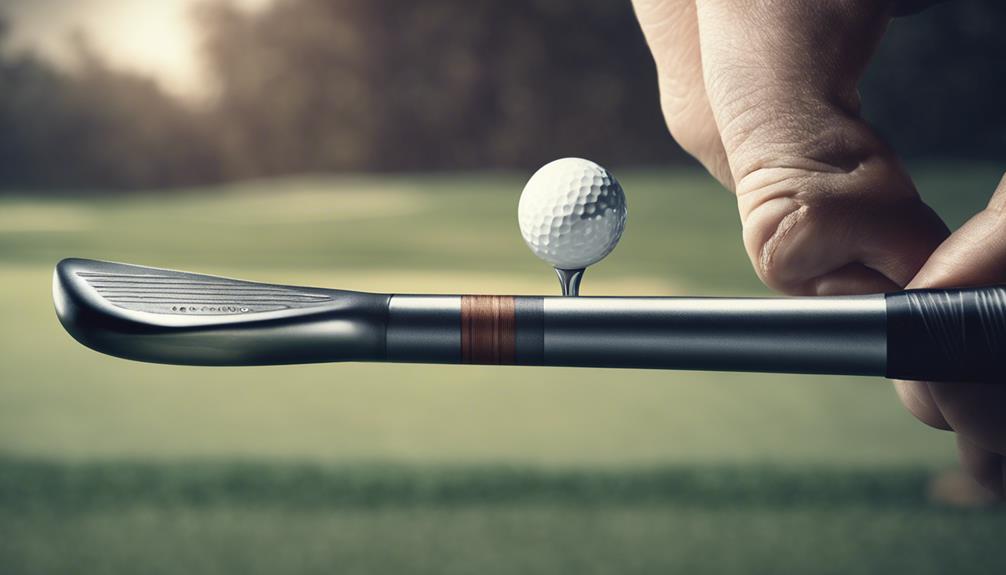
When choosing a shaft material, consider how it affects the feel and feedback you get during your swing, as this can significantly impact your overall performance and consistency. The right shaft material can provide the perfect balance of feel, feedback, and distance, which is essential for mastering your game.
Here's a comparison of graphite and steel shafts regarding feel and feedback:
| Shaft Material | Feel and Feedback |
|---|---|
| Graphite | Softer feel, reduced vibration, and increased forgiveness |
| Graphite | Suitable for slower swing speeds, promoting higher ball flight trajectory |
| Steel | More solid and controlled feel, enhanced accuracy and control |
| Steel | Better suited for faster swing speeds, providing consistent feedback |
Graphite shafts offer vibration-dampening properties, resulting in a softer feel at impact and reducing potential discomfort or fatigue during play. On the other hand, steel shafts provide a more consistent feel and feedback, making them better suited for golfers with faster swing speeds. By understanding the differences in feel and feedback between graphite and steel shafts, you can select the right material to improve your overall performance and consistency.
Shaft Durability and Longevity
Considering shaft durability and longevity is crucial, as it directly impacts the overall performance and lifespan of your golf clubs.
When choosing between steel and graphite shafts, you'll want to weigh their durability and maintenance needs. Steel shafts are known for their high durability and resistance to wear and tear, making them a popular choice for golfers who prioritize control and accuracy.
On the other hand, graphite shafts are more prone to damage and require more upkeep to maintain peak performance, but they offer a softer feel and vibration dampening properties.
The durability of a shaft also depends on the quality of the material and construction, with high-end shafts featuring advanced materials and manufacturing processes that enhance their lifespan.
To prolong the lifespan of your shaft, proper care and maintenance are essential, such as storing clubs in a dry place and avoiding extreme temperatures.
Advanced Material Technologies
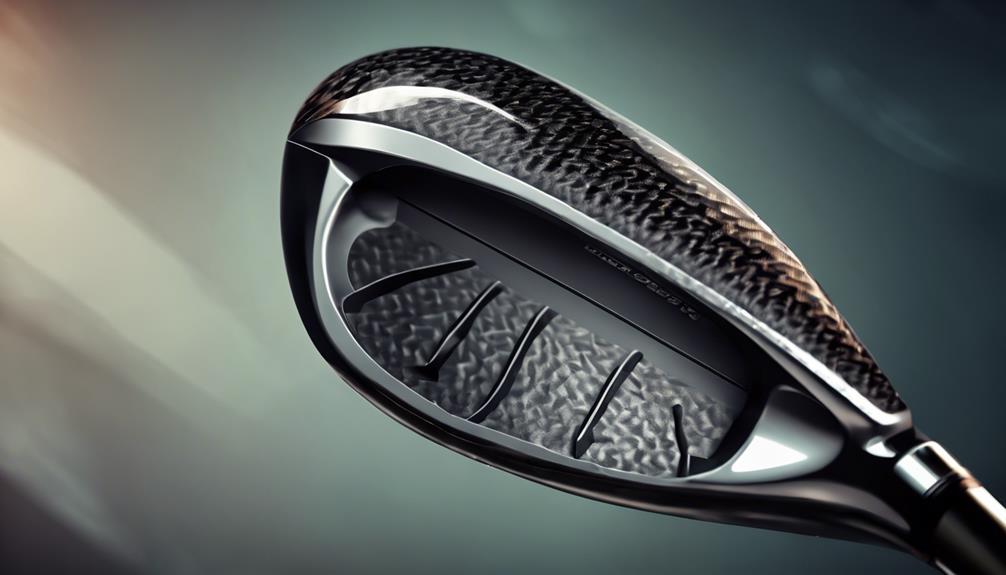
Advancements in golf shaft technology have led to the development of high-performance materials that substantially impact the overall quality and playability of golf clubs.
You're now benefiting from advanced material technologies that provide exceptional stiffness, strength, and minimal weight. High-modulus carbon fibers, such as Pitch 70 Ton, are a prime example of this. These fibers offer exceptional stiffness and strength while keeping the weight of your shaft to a minimum.
Low resin technologies, like MCFC (Maximum Carbon Fiber Content), also play a vital role in creating shafts that are both stiffer and lighter. This is achieved by using pre-preg with reduced resin content.
The orientation of materials in shaft design is critical, with 0-degree orientation affecting bending, 90-degree orientation providing hoop strength, and +/- 45-degree orientation (Bias) affecting twisting.
Fiber Reinforced Polymers (FRP) are used in advanced material technologies, consisting of a polymer matrix and fibers that provide strength and stiffness to the composite.
Unidirectional carbon fibers, which run in a single, parallel direction, provide maximum strength in the direction of the fiber, while woven materials come in various weaves and orientations to achieve specific properties.
Frequently Asked Questions
Is It Better to Have Steel or Graphite Shafts?
When choosing between steel and graphite shafts, you'll need to weigh, as steel suits faster swings and graphite suits slower ones. The cost factor, club head feel, and desired ball flight for distance gain will also influence your decision.
Do PGA Pros Use Steel or Graphite Shafts?
You're curious about PGA pros' shaft preferences, and the truth is, most Tour players opt for graphite shafts, citing better feel and precision, although some still swear by steel for its consistency and control, revealing intriguing shaft secrets and golfer insights tied to swing styles.
Does Tiger Woods Use Steel or Graphite Shafts?
You're probably dying to know: does Tiger Woods use steel or graphite shafts? Well, Tiger's preference has been graphite since his early adoption in the '90s, but he's experimented with steel, sharing valuable tour insights on his shaft switch.
How to Choose Shaft Material?
When selecting a shaft, you'll want to consider shaft flexibility, material durability, and clubhead compatibility, while also factoring in your swing style and personal preference to ensure a harmonious union that elevates your game.
Conclusion
As you weigh your shaft material options, consider this: will you prioritize the precision of steel, the lightness of graphite, or the adaptability of hybrids?
The right choice depends on your unique swing dynamics and personal preferences.
By understanding the properties of each material, you'll be better equipped to optimize your game.
Ultimately, the best shaft material for you'll be the one that harmonizes with your swing, releasing your full potential on the course.




